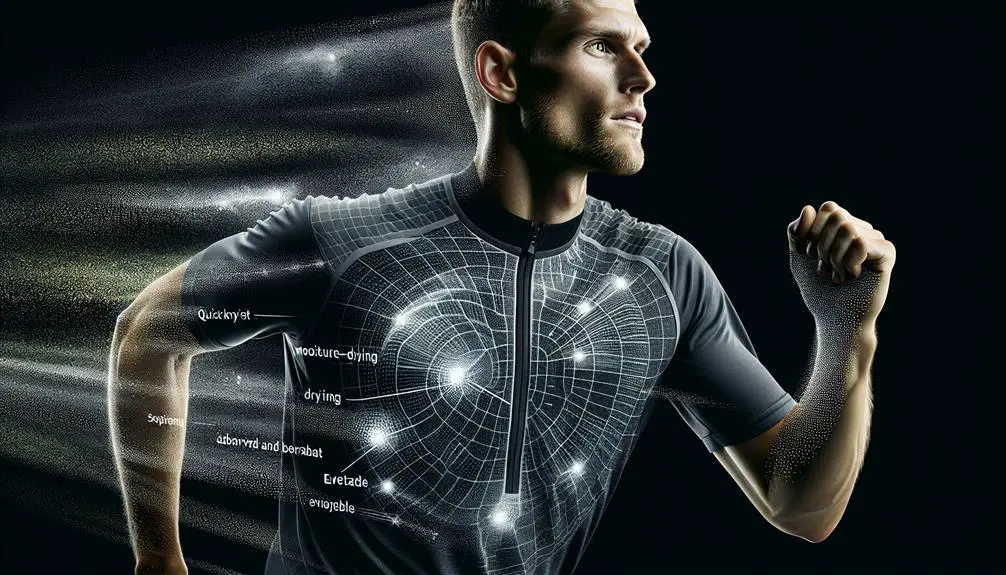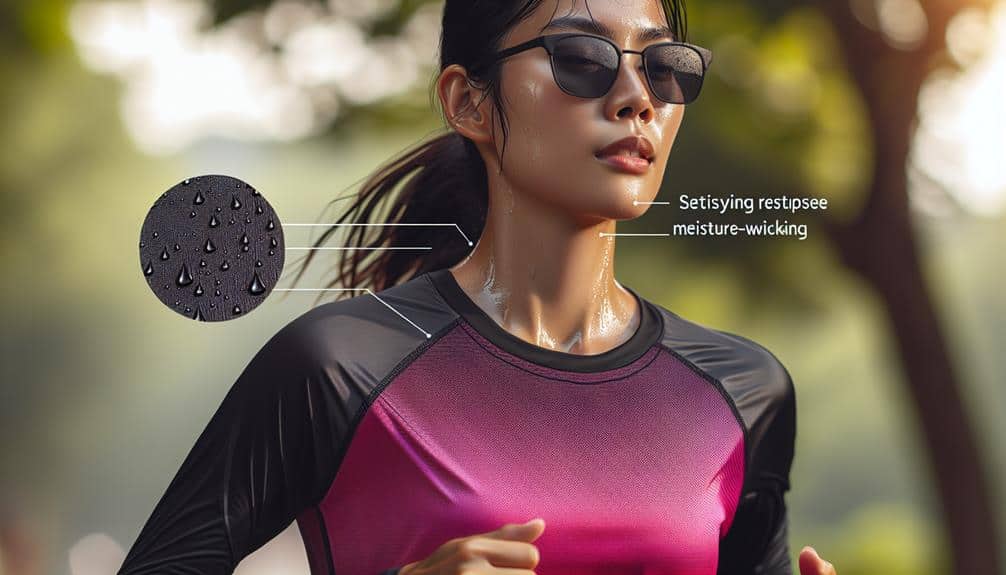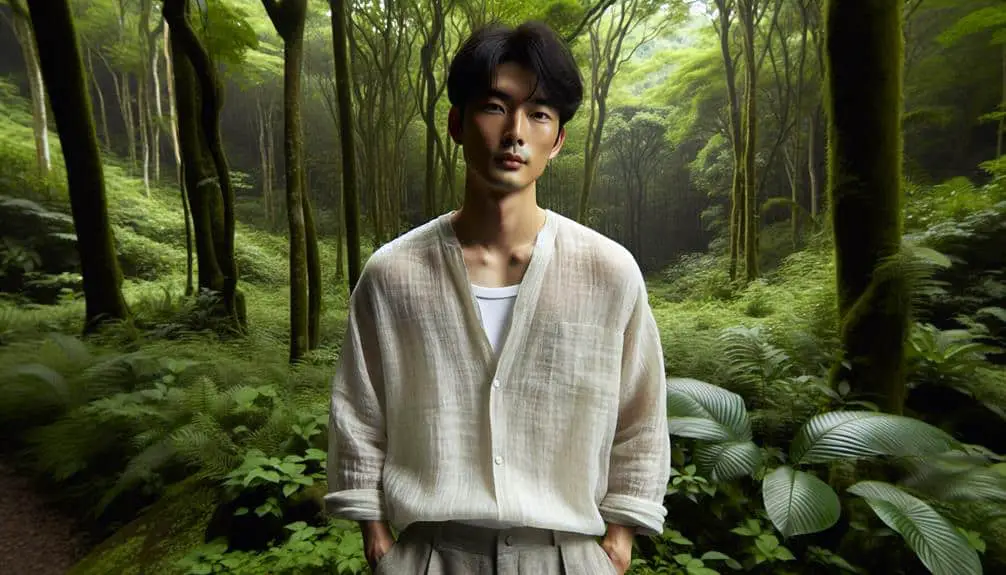Moisture-wicking fabrics are best for sports shirts because they efficiently manage sweat, regulate body temperature, and enhance performance during physical activities. They actively draw sweat away for faster evaporation, optimize sweat absorption, and prevent discomfort. These fabrics repel water, transport moisture efficiently, and keep you dry and focused. Their odor control, temperature regulation, and durability outperform regular sportswear. Polyester blends and nylon fabrics lead as top choices for their moisture-wicking capabilities. Engage in superior comfort, moisture control, and performance with these fabrics designed for athletes like you.
Key Points
- Enhance comfort and performance during physical activities.
- Regulate body temperature effectively for optimal performance.
- Prevent chafing and discomfort, improving overall experience.
- Superior moisture management compared to regular sportswear.
- Maintain freshness, dryness, and focus throughout workouts.
Benefits of Moisture-Wicking Fabrics
When selecting sports shirts, prioritize those made from moisture-wicking fabrics for enhanced comfort and performance. Sweat management is vital during physical activities, and moisture-wicking fabrics excel in this aspect by pulling sweat away from your skin to the outer surface of the fabric where it can evaporate more easily. This process helps in regulating your body temperature and keeping you dry throughout your workout. By efficiently managing sweat, these fabrics contribute greatly to performance enhancement.
The benefits of moisture-wicking fabrics go beyond sweat management. They also prevent chafing and discomfort often caused by wet clothing rubbing against the skin. Additionally, these fabrics are lightweight and breathable, allowing for better airflow and ventilation, which is essential for maintaining a comfortable body temperature during exercise. Overall, the use of moisture-wicking fabrics in sports shirts is a practical choice for anyone seeking to optimize their athletic performance and comfort simultaneously.
How Moisture-Wicking Fabrics Work
Moisture-wicking fabrics function by actively drawing sweat away from your skin to promote faster evaporation and enhance comfort during physical activities. This is achieved through advanced fabric technology designed to optimize sweat absorption and moisture management. The key lies in the specialized fibers used in these fabrics, which have hydrophobic properties, meaning they repel water. When you sweat, these fibers quickly pull the moisture away from your body and spread it across a larger surface area, allowing it to evaporate more efficiently. This process helps in regulating your body temperature by keeping you dry and cool.
The structure of moisture-wicking fabrics also plays an essential role in their functionality. The weave of these fabrics is engineered to transport moisture through capillary action, moving it from areas of higher concentration (your skin) to areas of lower concentration (the fabric's surface). This capillary action guarantees that sweat is rapidly pulled away from your body, preventing it from saturating the fabric and leading to a damp, uncomfortable feeling. By efficiently managing moisture in this way, moisture-wicking fabrics help you stay dry, fresh, and focused during your workouts.
Advantages Over Regular Sportswear
To upgrade your athletic performance, consider the importance of moisture-wicking fabrics over conventional sportswear. These advanced fabrics provide substantial advantages that can enhance your overall comfort and performance during physical activities.
One key advantage is odor control. Moisture-wicking fabrics are designed to pull sweat away from your body, which helps prevent the growth of odor-causing bacteria. This feature keeps you feeling fresh and confident throughout your workout, unlike regular sportswear that tends to retain moisture and odor.
Another important advantage of moisture-wicking fabrics is their superior temperature regulation properties. By efficiently wicking away sweat and moisture from your skin, these fabrics help keep your body cool in hot conditions and warm in colder environments. This temperature regulation feature is essential for maintaining top performance levels and preventing discomfort during intense workouts. In contrast, traditional sportswear can trap moisture against your skin, leading to potential overheating or chilling.
Embracing moisture-wicking fabrics for your sports shirts can greatly enhance your overall athletic experience and performance.
Top Moisture-Wicking Fabric Choices
Consider the top fabric choices for moisture-wicking sports shirts to optimize your athletic performance and comfort. When selecting a moisture-wicking fabric, it's important to prioritize fabric technology and performance.
Polyester blends are a popular choice due to their ability to efficiently wick away sweat from your body, keeping you dry and enhancing your performance. These blends are also known for their durability, guaranteeing that your sports shirt withstands rigorous activities without compromising its moisture-wicking properties.
Another excellent option is nylon fabric, which not only offers superior moisture-wicking capabilities but also provides exceptional comfort during intense physical exertion. Nylon is lightweight, breathable, and dries quickly, making it an ideal choice for sports shirts. Its durability ensures that the fabric maintains its moisture-wicking abilities even after multiple washes, allowing you to focus on your performance without worrying about your attire.
Care Tips for Moisture-Wicking Shirts
For peak performance and longevity of your moisture-wicking shirts, adhere to specific care instructions to maintain their moisture-wicking properties effectively. When washing moisture-wicking shirts, use cold water and a mild detergent to guarantee no damage to the fabric. Avoid using fabric softeners as they can clog the fabric's pores, reducing its ability to wick away moisture efficiently.
Turn the shirts inside out before washing to protect the outer surface where the moisture-wicking technology is usually located. Additionally, it's recommended to wash these shirts separately or with other similar performance fabrics to prevent friction damage during the washing cycle.
When it comes to drying techniques, opt for air-drying whenever possible to maintain the integrity of the moisture-wicking properties. If using a dryer, select a low heat setting to prevent excessive heat exposure that can damage the fabric. Avoid using dryer sheets as they can leave a residue that hinders the shirt's moisture-wicking capabilities.
Frequently Asked Questions
Are Moisture-Wicking Fabrics Suitable for All Types of Physical Activities, or Are They Specifically Designed for Certain Sports?
Moisture-wicking fabrics excel in various physical activities due to their ability to regulate temperature and enhance performance. Their fabric breathability suits different workout intensities, making them versatile for a range of sports and exercises.
Can Moisture-Wicking Fabrics Help Prevent Body Odor During Intense Workouts?
During intense workouts, moisture-wicking fabrics excel at odor control due to their advanced fabric technology. By swiftly drawing sweat away from your skin and drying rapidly, these fabrics inhibit the growth of bacteria that causes body odor.
Do Moisture-Wicking Fabrics Have Any Negative Effects on the Environment Compared to Traditional Sportswear Materials?
When considering the environmental impact of moisture-wicking fabrics, it's crucial to assess their sustainability initiatives. These materials often utilize advanced technologies that reduce water usage and energy consumption, making them more eco-friendly than traditional sportswear materials.
Are There Any Specific Washing Instructions or Detergents Recommended for Maintaining the Effectiveness of Moisture-Wicking Fabrics?
To maintain moisture-wicking fabric effectiveness, follow these best practices: wash in cold water, use mild detergent, avoid fabric softeners. Recommended products include sport detergents. These care instructions preserve the fabric's unique properties for peak performance.
Are There Any Potential Skin Irritations or Allergies Associated With Wearing Moisture-Wicking Shirts for Prolonged Periods of Time?
In the domain of potential discomfort, moisture-wicking fabrics may trigger allergic reactions in sensitive individuals over extended wear periods. Awareness of your body's response and fabric composition is integral to maintaining skin health.




